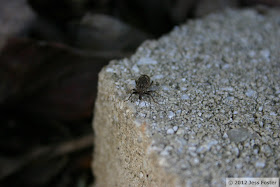I came across a grayish-white insect with a long snout the other day that I initially took to be a kind of plant bug. As it turns out, it was
Listroderes difficilis, the Vegetable Weevil. Now, I'd heard of weevils before but I didn't really know what they were. A weevil is a kind of beetle (order
Coleoptera) from the superfamily
Curculionoidea. It eats plants and can be damaging to crops. Its most unique feature is its downward-curving snout, called a rostrum, which is a "tubular extension of the head beneath the compound eyes." Females use their rostrum to bore holes in plants in which to lay their eggs, but most of the time weevils use it to eat, the mouthparts being located at the end. Also, a weevil's antennae are elbowed, becoming club-shaped at the ends and extending out from the rostrum. Unlike other beetles, a weevil's body, even its elytra (hard wing-coverings), is covered in hairs. Strangely, this particular specimen didn't have much hair at all on its legs. I don't know why; they should be quite furry.
 |
| Comparison of an insect, Pissodes strobi (white pine weevil) that possesses a rostrum (A) to one (Dytiscus marginalis, great diving beetle) that doesn't (B). Taken from Watson, L., and Dallwitz, M.J. 2003 onwards. British insects: water beetles. Version: 18th September 2012. http://delta-intkey.com. |
 |
| Head of Listroderes difficilis, http://www.forestryimages.org/browse/detail.cfm?imgnum=5319006 |
The above photo was taken from this site, which contains more close-up images of
Listroderes spp.:
http://www.forestryimages.org/browse/TaxImages.cfm?fam=529&genus=Listroderes.
Though there are other species in the genus
Listroderes, this one is characterized by the white V across its elytra.
Now, here are my photos:
 |
| The white V on the elytra, as well as the white line running dorsally down the pronotum. |
 |
| A portion of the wings protruding from beneath the elytra. |
 |
| A fortunate shot, showing how the first segments of the antennae can fold up into respective grooves along the sides of the rostrum. |
 |
| Again you can see part of the wings sticking out from under the elytra. |
References:
http://bugguide.net/node/view/110000 (taxonomy & photos of Vegetable Weevil)
http://www.extento.hawaii.edu/kbase/crop/type/listrode.htm (Univ. Hawaii on Vegetable Weevil)
http://www.ent.uga.edu/veg/solanaceous/veg_weevil.pdf (UGA article on Vegetable Weevil)
http://ipm.ncsu.edu/ag295/html/vegetable_weevil.htm (NC State on Vegetable Weevil)
http://books.google.co.uk/books?id=d0XSwMJLDg4C&pg=PA792#v=onepage&q&f=false (definition of rostrum)
http://io9.com/5817754/weevil-beetles-have-legs-that-are-just-like-tiny-screws (screw-like aspect of weevil legs)
http://science.jrank.org/pages/7362/Weevils.html (general article on weevils)
http://www.sciencedirect.com/science/article/pii/S1467803911000685 (rostrum structure & development in rice weevil)















No comments:
Post a Comment